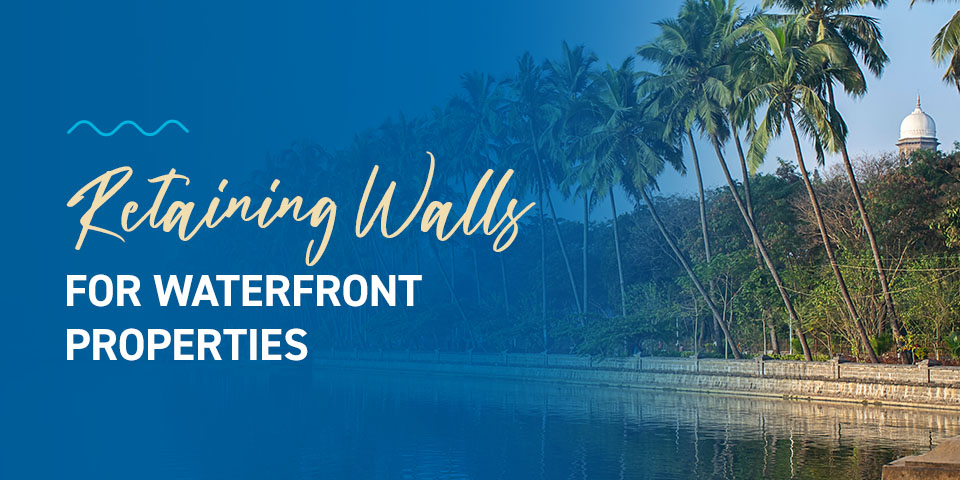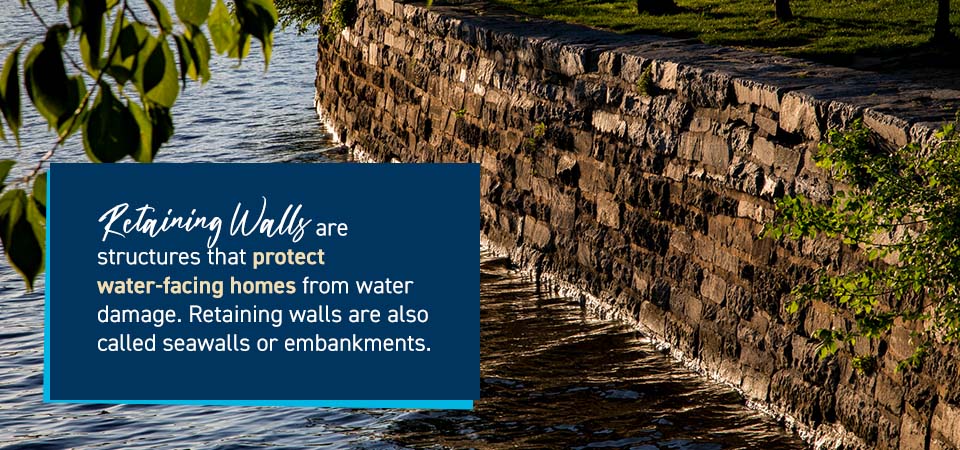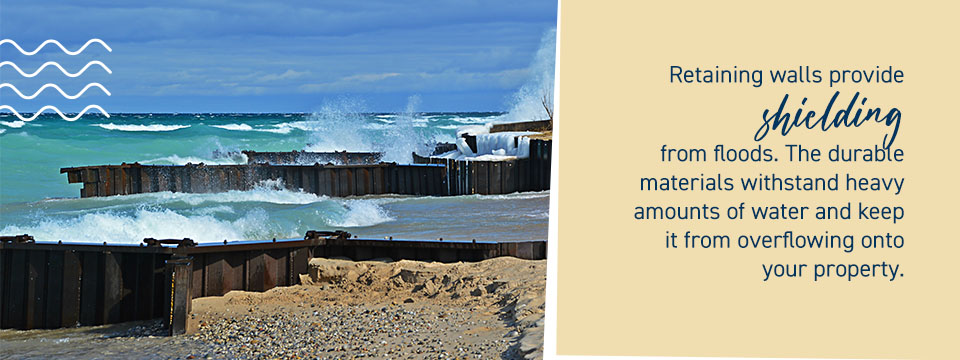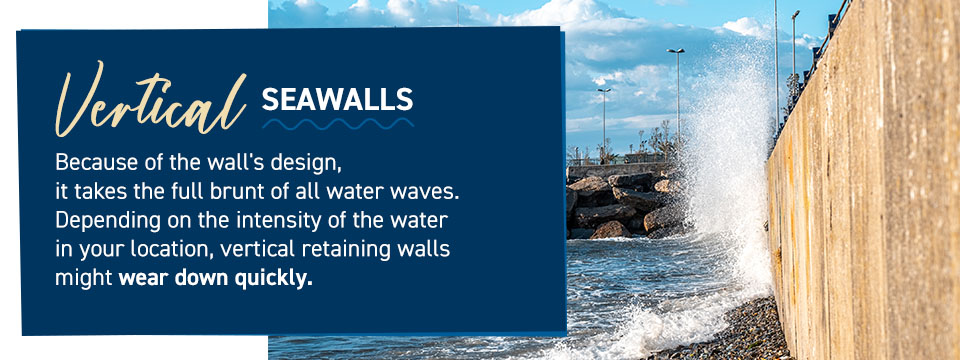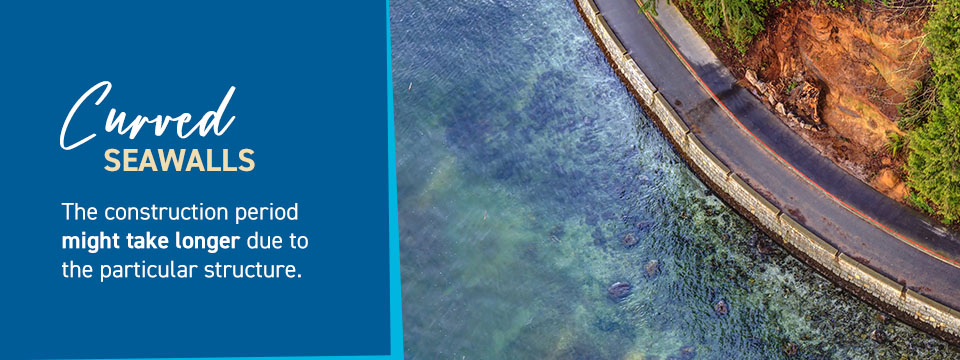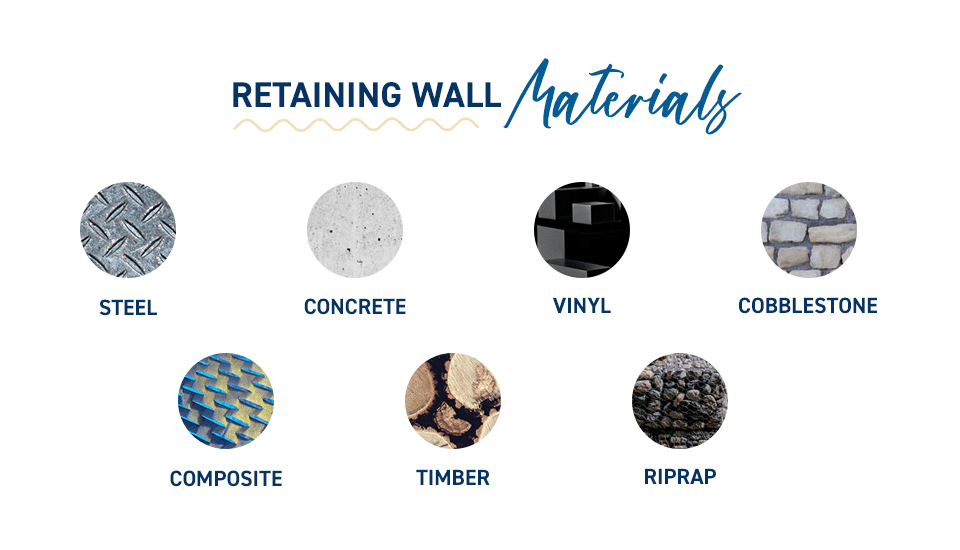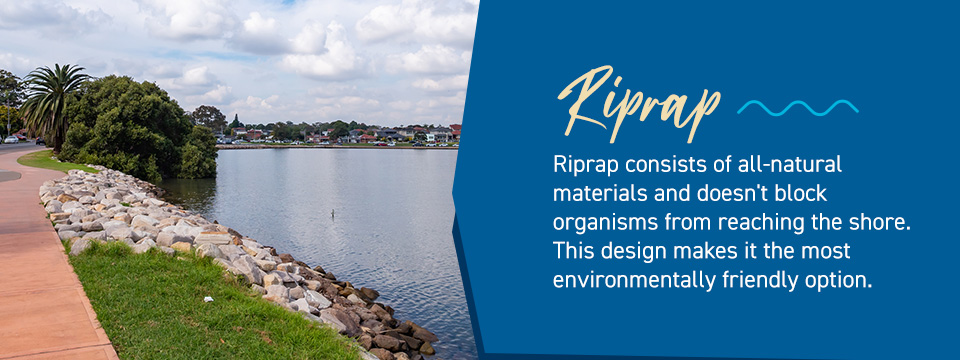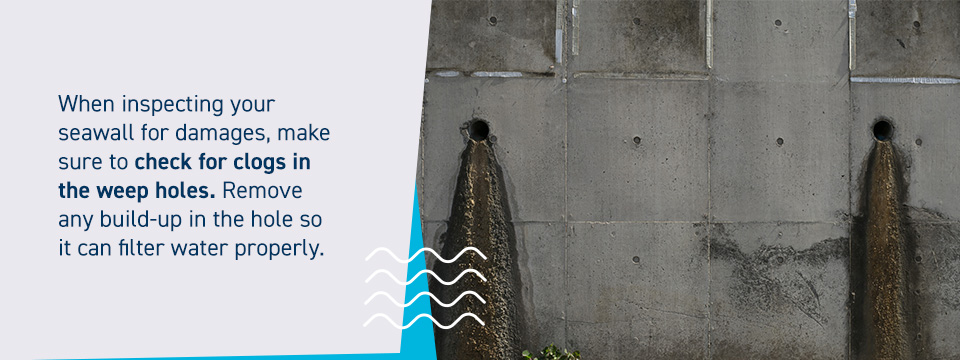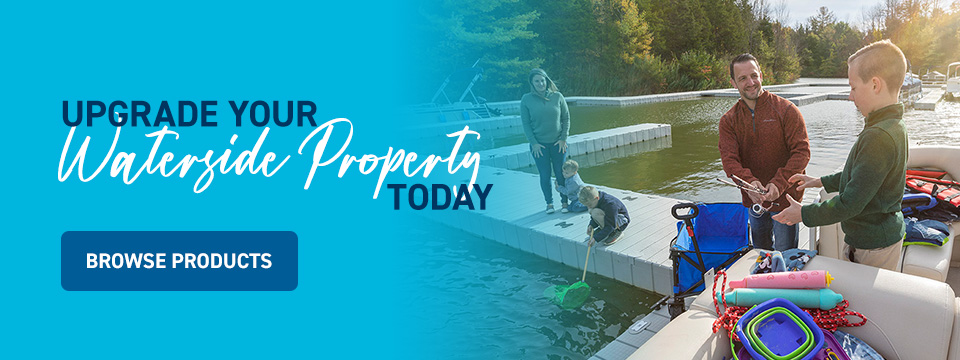Filters
Retaining Walls for Waterfront Properties: What You Need to Know
Waterfront properties are some of the most beautiful homes on the market. With their brilliant colors and waterside proximity, these properties offer comfort and beauty. The nearby water provides many fun opportunities, from swimming to waterskiing.
But being close to the water also brings challenges. Waterfront properties often encounter severe storms, and these can damage homes. Whether it’s wind damage or flooding, your waterfront home faces risks. And rising water levels break up land, causing erosion.
That’s where retaining walls come in. Retaining walls, or seawalls, divert water away from your home to avoid erosion or flooding. Constructing a retaining wall is a great way to protect your home from unfavorable weather.
Here’s everything you need to know about retaining walls.
What Are Retaining Walls?
Retaining walls are structures that protect water-facing homes from water damage. Retaining walls are also called seawalls or embankments. They’re usually constructed in a parallel line across the shore. They protect against erosion by directing the water into safer areas. You can construct a waterfront retaining wall using many different materials, from stone to concrete.
Depending on the design, retaining walls can also offer a new aesthetic to your property. The many colors and styles allow you to choose a wall that both guards your home and adds a new design. Overall, seawalls offer a strong defense against water intrusion for your waterfront home.
Benefits of Retaining Walls
Adding a retaining wall to your property could be the addition you need. With the walls’ protective properties and variety of styles, these structures offer many benefits for your home near the water.
Some advantages of a retaining wall include the following:
1. Prevent Land Erosion
Natural water flow and constant boat wakes can cause shorelines to recede. As the water pushes against the earth and moves away, the shore begins to break up and eventually erodes. And as the years pass, shorelines gradually become smaller. This reduction of land is a significant problem for waterfront homeowners because the receding land threatens to hurt their property.
Luckily, retaining walls offer strong protection against land erosion. The wall separates the land from encroaching water and protects it from damage. With this barrier in place, you can enjoy your waterfront home without thinking about receding shorelines.
2. Protect From Flooding
During rainfall or storms, water can rise quickly and potentially flood homes. Floodwaters are dangerous for both your home and physical health due to the toxins they carry. Flooding can cause long-term damage to the flooring, furniture and other essential elements of your home. Streams of water can sweep away cars and other possessions located outside.
Retaining walls provide shielding from floods. The durable materials, such as stone, withstand heavy amounts of water and keep it from overflowing onto your property. These walls also give you more time to make preparations in the case of an emergency.
3. Last a Long Time
When constructed correctly, retaining walls can last for many decades. Materials like steel and stone allow your wall to protect your property firmly. The retaining wall becomes a long-term investment for your property with proper maintenance and attention. Think of the retaining wall as a layer of protection that will last for future generations.
Seawalls also add property value. They accentuate property lines and define the width of docks and other waterfront elements. The added level of protection against flooding also increases the value of your home.
4. Use Less Space
Another benefit of retaining walls is the ease of construction. To build a seawall, you don’t need much space. You can construct one in most waterside areas with little difficulty. Because retaining wall lengths are often small, the overall cost of construction is relatively low. You get a strong source of protection against flooding and erosion at a typically low price.
Types of Retaining Walls
To accommodate for various tastes and needs, retaining walls are available in many styles. Each style has its pros and cons, so it’s best to research which type suits your personal needs. All can work as strong shields for your waterfront property.
The three major types of retaining walls include:
Vertical Seawalls
Vertical seawalls sit in an upright position right on the shore to prevent erosion from waves. They extend straight up into the air, similar to the structure of a fence. Vertical retaining walls are popular due to their strong form and reliability.
Here are more advantages of vertical seawalls:
- Easy to design: Because vertical seawalls are such a popular option, you will likely have little trouble finding suitable materials and designs. The simplistic, upright shape allows for easy planning.
- Easy to construct: This aspect goes hand-in-hand with the design. Vertical retaining walls’ simple design allows for an easy installation.
These are some potential disadvantages of vertical seawalls:
- Endures full force of waves: Because of the wall’s design, it takes the full brunt of all water waves. The water cannot slow down before hitting the wall, so all of its force hits the structure. Depending on the intensity of the water in your location, vertical retaining walls might wear down quickly.
- Experiences potential undercuts: Vertical seawalls might also experience undercuts as the water gets under the wall. Because there is no structure in place to divert the water below, water may creep in under the wall and manage to reach your property.
Curved Seawalls
Curved seawalls, also called stepped seawalls, are another retaining wall style. Designers construct these walls with a large, inward curve toward the center of the wall. The curve works naturally to redirect water, as it mimics a wave’s shape.
Here are several pros of having a curved seawall:
- Water diversion: Curved retaining walls offer a natural way to divert water away from your home. As the water travels toward the wall, it rises up the curve and then moves back into the sea or river. In this way, it naturally flows back to its source without reaching your property.
- Durability: Unlike vertical seawalls, curved seawalls do not experience the full force of waves. Instead, the water slows as it reaches the curve and then moves away. Because of this, curved seawalls often last for long periods and experience less erosion.
Here are some things to keep in mind about curved seawalls:
- Limited aesthetics: Curved seawalls often aren’t available in as many materials or shapes as other styles. If you had a specific aesthetic in mind, you might not appreciate the appearance of the curved seawall.
- Higher price: The specific design of curved seawalls often makes them more costly to build. The construction period might also take longer due to the particular structure.
Mound Seawalls
Mound seawalls are slightly different from the other two options. They’re made of concrete blocks, rocks and other stones. Instead of facing the wave directly, mound retaining walls disperse the wave upon contact.
These are some benefits of mound seawalls:
- Less expensive: Mound seawalls are usually the most cost-effective option for seawall construction, ideal if you have a larger stretch of property to protect.
- Effective at dispelling waves: These seawalls are great at reducing the strength of waves and breaking them apart. The various rocks act as shields for your property, preventing ocean waves from reaching the land.
And mound seawalls come with these considerations:
- Cannot withstand high-pressure waves: Mound seawalls work best with calm waters. They usually can’t endure high-velocity waves and might actually begin to break up upon impact. After the materials divide, it could create an easy avenue for water to enter your property.
- Wears away more quickly: This style of wall isn’t quite as durable as the other options. If you live in an area with high-velocity waves, the rocks might wear away quickly, meaning you’ll need to make frequent replacements and repairs.
Retaining Wall Materials
You can build a seawall with a variety of materials. Similar to the styles of retaining walls, each material has its own advantages and disadvantages. You might choose a particular material depending on what’s most important to you. If you want the seawall to match a specific aesthetic, you might single out the material that matches it best. Or, if durability is the most essential factor for you, you might choose the strongest substance.
Some common materials used for retaining walls include:
- Steel: Steel is an extremely durable material. A steel seawall could last more than three or four decades with proper maintenance.
- Concrete: One of the most common retaining wall materials, concrete is extremely solid. Concrete will also last for decades as long as you properly patch cracks and holes.
- Vinyl: A newer option, vinyl is available in many colors and provides lasting protection for your property — the material doesn’t corrode, so it can last longer than steel. The only downside is that it’s difficult to install and might take longer than other options.
- Cobblestone: Cobblestone is a unique and beautiful option for your seawall. It works well at breaking up waves and provides an aesthetic view.
- Composite: Engineers design composite seawalls with fiber-reinforced polymers. These fibers offer extreme durability. However, composite retaining walls are sometimes more expensive due to their high-quality makeup.
- Timber: Wooden seawalls are popular in more rural areas. They’re effective at keeping water away but require keen maintenance to stay in good shape.
- Riprap: Riprap consists of various large stones along the shoreline. These retaining walls are simple to construct and also easy to maintain. If one stone sustains damage, you can simply replace it with a new one. Riprap is also the most environmentally friendly way to construct a seawall.
Ask professionals for help on how to build a retaining wall. They can recommend the right materials for your needs.
How to Choose the Right Retaining Wall
Once you decide to install a retaining wall for your property, choosing from the many options takes some time. The best way to select a seawall style is to consider your circumstances and what type suits them best.
Here are some things to consider as you select the best seawall for you.
Body of Water
The most important thing to consider when selecting a retaining wall is the body of water it will border. The size and volume of the water should inform your selection. The water’s tendencies will affect how long your seawall lasts.
Consider these water qualities:
- Size: Small bodies of water are often calmer than larger ones. Think about the difference between a small lake, a gushing river and strong waves. If you live next to an ocean, you might consider one of the most durable seawall options, like a curved concrete wall. But if you reside by a calm lake, using riprap or mound retaining walls might be better.
- Currents: The strength of the water’s currents should also impact your decision. Intense waves wear down retaining walls, so you should consider the most durable materials, like concrete. Calm or slow-moving waves are much gentler, so extreme durability might not be at the forefront of your decision.
- Salt content: Lastly, the salt content is another critical consideration. Salt doesn’t interact well with steel materials, so steel might not be the best choice if you live by a body of saltwater.
Conditions and Activity Levels
You should also think about the shoreline conditions and how often people use the water for recreation. Both of these elements impact how much wear the wall will endure:
- Shoreline conditions: Take note of the shoreline features, such as the material of the shore and its incline. Some seawalls work better with specific soils, while others don’t work well with inclines. Be sure to research how well your intended seawall meshes with your shoreline conditions.
- Activity levels: Activity on the shoreline also influences seawalls. For instance, if waterboarding or jet skiing is typical by your location, these activities produce boat wakes. Boat wakes are harsh against shorelines and seawalls, so you should consider a strong retaining wall. But if your land is mostly serene, this might not be as much of a consideration.
Appearance
Consider how important seawall appearance is to you. Some retaining walls offer aesthetic beauty, while others don’t have many design options. If you want a seawall that matches your home or another design, take into account how customizable each option is.
For instance, vinyl and composite materials are available in many colors, but wood or timber seawalls are harder to customize. And some seawalls are overall more attractive than others, like cobblestone. Consider how crucial the seawall’s image is and weigh that with your other needs.
Eco-Friendliness
You might also think about eco-friendliness. If this is a make-or-break component for your decision, research which styles use the most sustainable materials. Seawalls affect sea life and the surrounding earth, so it’s important to consider this as you select your wall.
Riprap consists of all-natural materials and doesn’t block organisms from reaching the shore. This design makes it the most environmentally friendly option. And vinyl and composite, while highly durable and customizable, don’t use entirely sustainable materials.
Budget
Your finances are also an essential factor in your decision. Some options are pricier than others, so try to keep that in mind as you finalize a retaining wall choice. You should also try to weigh quality with your budget. Don’t immediately opt for the lowest price to save money, because it could need more costly replacements later. But don’t select a seawall that’s way out of your price range, either. Try to find a balance between your monetary lengths and the best retaining wall style.
Maintaining and Repairing Your Retaining Wall
Once you install the best retaining wall for you, it’s essential to regularly maintain and repair it. Here’s an overview of steps to take for seawall maintenance.
1. Check for Imperfections
The best way to make sure your seawall is in good shape is by regularly checking for holes or other imperfections. The earlier you spot these problems, the less long-term damage occurs to your wall. These are some things to look for during your inspections:
- Plant growth: While some plant growth is OK, check closely for weeds. These can cause cracks and ruin the foundation of your retaining wall. The cracks might allow water to seep in and reach your property. Make sure to remove any weeds as soon as you notice them.
- Holes or cracks: Look out for small holes and cracks in your retaining wall. Even small holes can negatively affect your seawall in the long term. Cracks slowly reduce your seawall’s ability to withstand water pressure. If left unchecked for too long, the cracks could ruin your entire seawall.
- Structural components: Lastly, be sure to check for issues specific to your seawall type. If you have a vinyl seawall, cracks are the most significant problem you should watch for. But if you chose wood as your material, look for rot or splits in the wood. With riprap, missing or dislodged stones are a sign of an issue. Make sure to keep the specifics of your wall in mind as you inspect it for damage.
2. Repair Minor Issues
In many cases, you can fix some of the smaller retaining wall issues yourself. Use simple fixes to get your retaining wall back to its best shape. Some quick ways to solve minor problems in your seawall include:
- Clear weep hole clogs: Weep holes relieve some water pressure from sea walls by allowing some water to drain. They’re beneficial during heavy storms and rainfall when retaining walls experience a lot of excess water. When inspecting your seawall for damages, make sure to check for clogs in the weep holes. Remove any build-up in the hole so it can filter water properly. Otherwise, the strain might cause cracks to form.
- Use marine grout for cracks: If there’s a small crack, try filling it with marine grout for a simple fix. You can also use types of liquid concrete for this process.
- Try waterproof spray: Some seawalls work well with waterproof sprays. These add an extra layer of protection against water erosion.
3. Watch for Signs of Major Issues
While you can resolve some seawall problems yourself, sometimes the issues require maintenance professionals. Knowing the difference between a minor problem and a big one helps you understand when to call for help or when to handle it on your own.
Signs of a seawall needing major repairs could be:
- Rotating walls: If your seawall moves or sinks, it indicates that the water pressure has become too much for the wall to hold. If you don’t address this problem quickly, the entire foundation might collapse.
- Sinkholes: If you notice a loss in soil, this might mean water is seeping through the wall. As it flows through the wall or under, it weakens the soil and causes it to collapse. If left unresolved, it could result in severe erosion of your property.
- Rust: Any signs of rust indicate water damage to your seawall. This rust could spread to the other parts of your wall and make it weaker.
If you notice any of these signs or other major issues, contact a professional maintenance team. These teams can assess the extent of your seawall damage and provide the necessary repairs. If you have any concerns about your seawall, you might consider calling experts to ensure you take the right next steps.
Invest in Upgrades for Your Waterside Property Today
A retaining wall is just one way to upgrade your waterside property. Docks, ports, launches and other accessories give you access to fun on the water. EZ Dock has provided premier water products for our customers since 1991. We are a leader in floating docks and other water products, perfect for waterfront properties.
Contact us or request a quote today to learn more about the long-term investments we can provide for your waterfront home.

